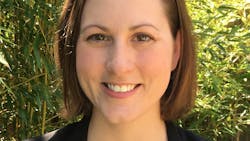2019 40 Under 40: Laura Wolfgram
- One word to describe yourself: Passionate
- Alma Mater: Beloit College and Washington University in St. Louis, University of Southern California
- Favorite book: “The Handmaid’s Tale” by Margaret Atwood
- Favorite TV show: “This is Us”
- Favorite movie: “Elf”
- Favorite hobby(s): Traveling, attending kiddie pool parties and walks around the block meeting the neighbors with my one-year-old son.
- Fun fact about yourself: There is always room for dessert!
- Favorite station or stop that you have ever visited or frequent (and why): Any and all Union Stations. They provide so much history and beauty; there is so much bustling activity and you feel like you have arrived. The newly renovated Great Hall at Chicago’s Union Station is beautiful!
- Favorite route you have ever ridden or frequent (and why): The train from Edinburgh to London. The ride is absolutely beautiful, and it sure beats being 35,000 feet in the air.
Laura Wolfgram has spent 12 years in the transit industry and has worked with over two dozen transit agency clients. She currently serves as a senior consultant and fare policy practice lead at Four Nine Technologies, where she has been for the past four years. Previously she worked at Fehr & Peers, Jacobs Engineering and CH2M.
Before entering the industry, Wolfgram received a dual bachelor’s degree in civil engineering and mathematics, and she received a master’s degree in planning. She has since refined her area of focus to fare policy.
In line with her focus, Wolfgram helped establish the Four Nines fare policy practice where she constructed the Four Nines Fare Model, a fare analysis tool that can forecast the relative ridership and revenue impacts of different fare alternatives. The methodology of the model is based research and Wolfgram’s years of experience conducting ridership and revenue modeling to evaluate the impacts of changes to transit fare policies, structures, products and pricing. She designed the model to not only take into account price elasticities for different customer market segments but also to allow riders to shift between fare products as the relative average fare per boarding changes. This model capability more accurately reflects expected real-life changes in rider behavior.
To date, Wolfgram’s model has been used in nine different fare study engagements, and output from the model has provided information needed for many related Title VI fare equity analyses. At the completion of these projects, the final model files are given to the client to see how the model produced the ridership and revenue predictions they use in their decision making. She also wrote a user manual for the model that she gives to the client.
If her clients don’t have enough data to inform the model, she researches past rider surveys and works to design surveys and sometimes helps distribute them.
For all her projects, Wolfgram develops a kickoff interview guide with questions targeting the specific insight each stakeholder can bring to the project and talks to stakeholders from the executive level down to the community. She also frequently partners with other professionals to being Title VI, environmental justice and public engagement experience to her clients.
In addition to providing mentorship, Wolfgram has also presented at industry forums and events. At the 2012 TRB Annual Meeting, she partnered with her client counterparts at the Santa Clara Valley Transportation Authority to present “Steps to Leading Change: A Transportation Agency’s Business Plan Approach.” She’s also presented at the 2015 APTA Revenue Management and Fare Collection Summit where she talked about “Reviewing Fare Policies with Smart Card Implementation.”
“...Transit planning has really provided me with the opportunity to combine my interests in data, people, and problem solving.”
“Although the majority of my work right now is focused on fare policy, each project is so unique and provides an opportunity to explore new challenges and develop new solutions.”
“Always be open to hearing different perspectives to get a fuller picture; likely the solution requires collaboration.”
